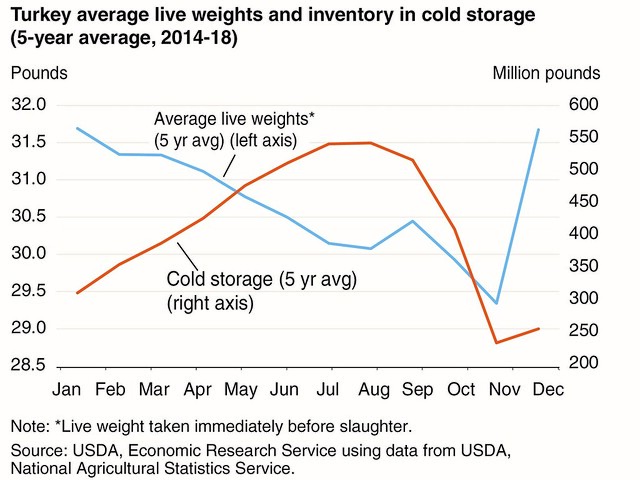
Did you know that between 2014 and 2018 approximately two thirds of U.S. turkey meat was produced in just six states: Minnesota, Indiana, North Carolina, Virginia, Arkansas, and Iowa? Minnesota, the largest producer, produces more than 15 percent of U.S. turkey meat annually.
If you eat turkey this holiday season, more than likely it was purchased frozen. Sixty percent of annual turkey production is chilled (as opposed to frozen); however, to produce enough turkey for the holidays – when consumption is by far the highest – producers begin storing turkey in frozen storage as soon as the holiday season ends. Inventories typically peak the following August, reaching levels equivalent to about 5 weeks of production. From September to November, frozen inventories decrease by about 75 percent.
Approximately 57 percent of federally inspected harvested turkeys are toms (male), while about 43 percent are hens (female). One of the main differences is size. Toms are grown to an average live weight of 41 pounds, while hens average 17 pounds. Translating this to the retail level, if the turkey you purchased at the store weighs 16-24 pounds, then it’s a tom, if it weighs 8 to 16 pounds, then it’s a hen.
Average live weights vary depending on the time of year. From January to May, producers focus on producing large turkeys, which are suitable for processing. From June to November, however, production shifts towards smaller, whole turkeys, which are suitable for holiday centerpieces. Average live weights are highest in January and generally trend down each month through November. Between 2014 and 2018, average weights decreased by more than 7 percent between January and November. Average live weights are the lowest in November, mainly driven by lighter weight toms, as well as a higher share of hen production.
Whether you’ve already enjoyed a turkey for Thanksgiving or are planning to include turkey in your upcoming celebrations, visit our Turkey Background and Statistics page for more stats.
